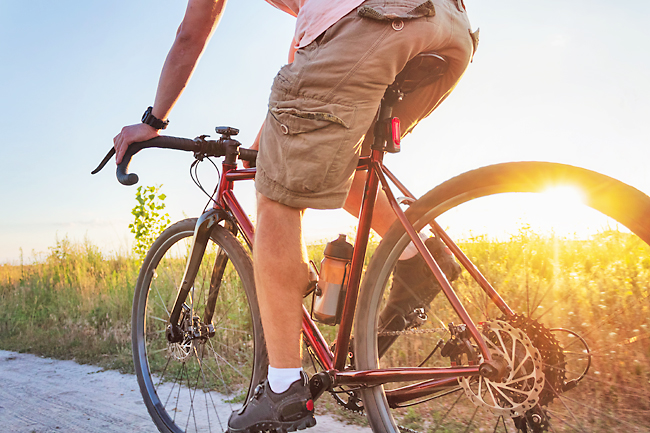THE WASHINGTON POST – Krystal Salvent was an avid road cyclist – until she found herself lying in a ditch after a driver ran her off the road. That experience prompted the Boulder, Colorado, co-leader of Black Girls Do Bike Denver to buy her first gravel bike. “If I can remove that obstacle for myself and focus more on my bike handling, rocks and maybe rattlesnakes, I think I’m a little better off,” she said.
Salvent represents the growing community of gravel cyclists, who prefer pedalling alongside fields and forests rather than cars and trucks due to safety concerns. The past 10 years saw a 37 per cent increase in accidental bike-related injuries.
“There’s this sense of, ‘Do I really want to be on the road?’,” said executive director and sports industry analyst at the NPD Group Dirk Sorenson, a market research firm. After steady growth since 2018, gravel bike sales over the 12 months ending in February 2022 jumped 62 per cent compared to February 2020, Sorenson said.
Gravel bikes feature gearing and geometry similar to road bikes and the wider, knobby tyres of a mountain bike. While they lack the shock-absorbing suspension forks and rear shocks that mountain bikes have, gravel bikes allow access to off-road terrain, including muddy trails, dirt roads and crushed gravel paths.
Co-founder of Pedal 2 the People Rachel Olzer, a community of cyclists of colour, credited much of gravel’s popularity to its accessibility. She said many cyclists want to avoid traffic and explore remote areas without the challenges of mountain biking, which include a steep learning curve and a degree of fearlessness required to stay upright on technical terrain.
Gravel biking, which typically takes riders over more forgiving terrain, has a relatively low barrier to entry. Inspired to explore gravel cycling but not sure where to begin? Here are some factors to consider.

WHERE TO RIDE
Start with a shorter route and park at the trailhead “in case you get in any kind of pickle where it’s five miles in and this is actually a lot harder than (you) thought”, Olzer suggested.
One of the most important route-planning considerations is the surface you’re riding on.
“’Gravel’ is a little bit of a misnomer,” said co-founder and executive director of Dirty Freehub Linda ‘Gravel Girl’ English, a Bend, Oregon-based non-profit whose mission is to share gravel cycling routes. The word encompasses a wide variety of surfaces, including gravel of all sizes and textures, pavement, forest roads, fire roads, singletrack (mountain bike trails) and dirt.
Because gravel routes aren’t necessarily labelled as such, talking to other cyclists is the best way to get accurate information about the terrain, road closures and potential hazards, English said. Most bike clubs have Facebook groups for tip sharing, or you can ask your local bike shop for recommendations. Online resources include Gravelmap, which shares dirt roads, and Dirty Freehub, which offers curated routes across the West and gives details about elevation, technical difficulty, cellphone coverage and e-bike access.
Strava, a fitness tracker that lets users share routes, can also be helpful – but it’s not perfect.
Mer Parra, a service technician and bike marketing manager at Dirt Rooster Bicycles in Catonsville, Md, said she used the “heat map” feature, which shows popular routes, to plan a cross-country gravel tour. While this worked well at times, because these maps represent historical rather than real-time data, she encountered “all sorts of things”, such as a washed-away bridge and a flooded path that forced her to reroute.
TYRE PRESSURE
While you should always inflate your tyres before a ride, determining how much is tricky, English said. The recommended pressure stamped into every tyre’s sidewall, is a rough guideline. “It depends on your weight, where you are riding and tyre width,” but most people ride with too much pressure, English said. Lower pressure gives you more traction on rough terrain.
She suggested free online tools as a starting point and adjusting tyre pressure midride as needed. “If the road gets chunky, washboard or sandy, we let the air out,” English said.
WHAT TO BRING
Just as you would for road or mountain biking, at minimum bring tools to change a flat. While all riders should have a tyre lever and a couple of CO2 cartridges or a pump, additional must-haves depend on the type of tyres.
Co-founder of Dirty Freehub Kevin English along with his wife, Linda, said that if you’re running tubeless tires, you need a small bottle of sealant, a valve core remover (necessary to create an opening in which to insert the sealant) and dynaplugs, which plug punctures and inflate tyres. Many gravel riders prefer tubeless tyres because you can run lower pressures without the risk of the tube pinching against the rim.
Salvent suggested bringing two extra tubes, whether you’re using tubes or tubeless tyres, in case of a major gash, as well as a multi-tool for basic mechanical problems.





